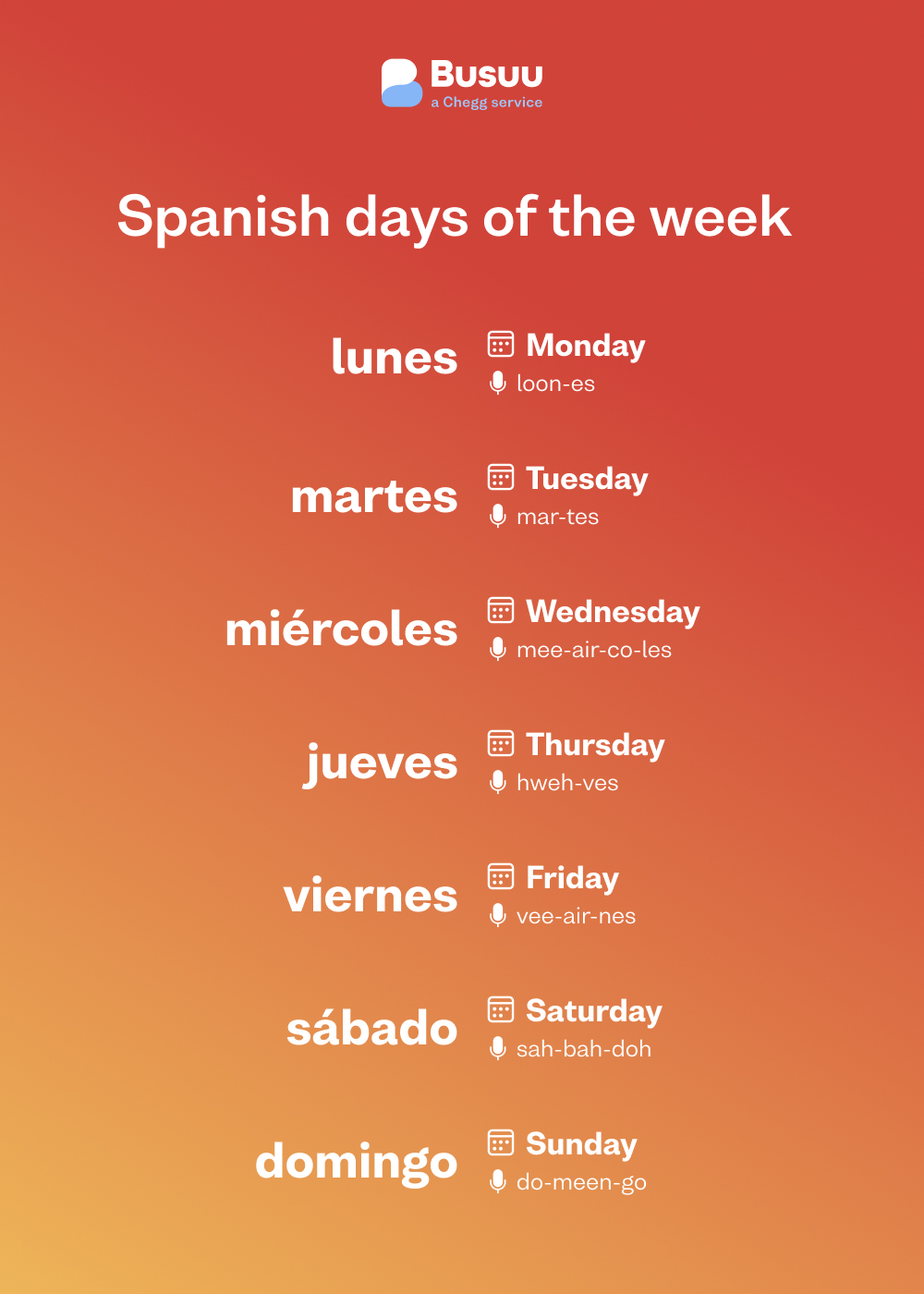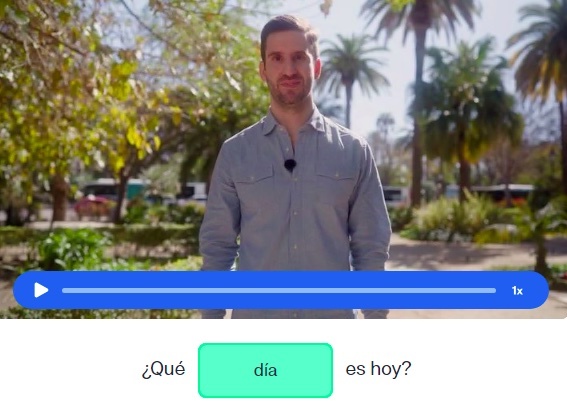Days of the Week in Spanish
Memorize the Spanish days of the week with this handy guide.
Knowing the days of the week in Spanish can come in handy, whether you’re learning to chat with a neighbor or live abroad.
After all, if you don’t know what day your friend wants to meet, your class will take place, or your new boss wants you in the office, it’ll be hard to get much done.
Fortunately, it’s easy to learn the Spanish days of the week. In fact, you’ll be well on your way to remembering them by the time you finish reading this article! We’ll teach you how to pronounce, remember and use the seven days of the week in Spanish.
We’ll answer questions like, are days of the week capitalized in Spanish? What are the Spanish days of the week abbreviations? And, which Spanish day is named after a goddess of love?
Read on to find out!
Spanish days of the week
| English | Spanish |
|---|---|
| Monday | lunes |
| Tuesday | martes |
| Wednesday | miércoles |
| Thursday | jueves |
| Friday | viernes |
| Saturday | sábado |
| Sunday | domingo |

What are the days of the week in Spanish?
When we look at the Spanish days of the week, the names might seem unfamiliar, but they actually come from many of the same sources as the English days of the week!
Learning these sources can help you remember them, so let’s take a closer look.
Monday – lunes
Monday comes from the word “moon” in German. Lunes comes from "luna", the Spanish word for moon. Monday? It’s a moon day.
Tuesday – martes
In English, Tuesday is named after Tyr, the Norse god of war. Martes comes from Mars, the Roman god of war. Tuesday is a day of ‘making war’ . Fun fact: In Spain, Friday the 13th isn’t bad luck – it’s Tuesday the 13th instead!
Wednesday – miércoles
Our words for Wednesday don’t have much in common, but if you know the Roman pantheon of gods – or the names of the planets – you can remember that miércoles is for Mercury, the Roman god of messages and communication. On Wednesdays, we send messages.
Thursday – jueves
In English, Thursday is Thor’s day. In Spanish, it’s Jupiter’s. If you know your gods of thunder (...do you?), you’ll know that these two have a lot in common. On Thursday, we jump from the thunder.
Friday – viernes
Friday matches up with another planet and Roman deity – Venus. Friday night is date night, after all, and Venus is the goddess of love.
Saturday – sábado
Saturday is named sábado for the sabbath, a day of rest. Sábado, sabbath, the first day of the weekend! On Saturday, we take a break.
Sunday – domingo
And, last but not least, Sunday is domingo, derived from the Latin Domenica. It’s another Biblical root, meaning “The Lord’s Day”. That’s the root, but if you’re not into religion, you could also think of it as a day to celebrate Domingo Faustino Sarmiento, the nineteenth-century Argentine activist and intellectual.
Spanish days of the week pronunciation and memorization chart
| English | Spanish | Pronunciation | Remember... |
|---|---|---|---|
| Monday | lunes | loon-es | moon |
| Tuesday | martes | mar-tes | Mars (war) |
| Wednesday | miércoles | mee-air-co-les | Mercury (messages) |
| Thursday | jueves | hweh-ves | Jupiter (thunder) |
| Friday | viernes | vee-air-nes | Venus (date night) |
| Saturday | sábado | sah-bah-doh | Sabbath (break) |
| Sunday | domingo | do-meen-go | Domingo (my friend) |
Mastering the days of the week in Spanish: 7 things you need to know
Ok, now you know how to say days of the week in Spanish. Let’s put this new knowledge into action! Here are a few important rules and pieces of information you’ll need if you want to start chatting schedules with your Spanish-speaking friends.
1. Skip the “on”
In English, we say that we do things “on Monday”, “on Saturday nights,” and so on. But in Spanish, we use el or los (the) in place of on – and nothing else. Here’s what that looks like:
-
El martes voy a comer con mi abuela.
“On Tuesday I'm having lunch with my grandma.” -
Los sábados corro por el parque.
“On Saturdays I run in the park.”
(You might be tempted to throw in an en. Don’t do it!)
2. Start with Monday
In the English speaking world, calendars often start on Sunday. In Spanish speaking countries, however, the week starts on Monday – just like the work week or school week.
3. Learn the X-ception
The usual Spanish days of the week abbreviations come with a little surprise that could trip you up!
While the English short form for the 7 days of the week looks like this, starting at Sunday and ending with Saturday:
S M T W T F S
(or S M T W R F S, in some schools)
In Spanish speaking countries, it goes:
L M X J V S D
It starts on lunes and ends on domingo. X represents miércoles to avoid confusion with martes. So if you get a class schedule that asks you to show up at 9 am on L and X, you know that’s lunes (Monday) and miércoles (Wednesday).
Fortunately, shortening the days the way we do if we write Mon. or Wed. in English is much easier. Those abbreviations look like this:
Spanish days of the week abbreviations
| Day | Abbreviation |
|---|---|
| lunes | lun. |
| martes | mart. |
| miércoles | miérc. |
| jueves | juev. |
| viernes | vier. |
| sábado | sáb. |
| domingo | dom. |
4. Capital letters not (usually) required
Back to that question, are days of the week capitalized in Spanish?
You might have noticed this already, but when we write the days of the week (you know, lunes, martes, miércoles...) in Spanish, we don’t capitalize them unless they appear at the beginning of the sentence. Like how the work ‘like’ is capitalized at the beginning of this sentence, but not anywhere else. You get the idea.
Not capitalized
Nos vemos el lunes.
“See you on Monday.”
Capitalized
When writing the date at the top of a letter:
Lunes, 16 de agosto de 2021
“Monday 16 August 2021”
5. It’s a boys’ club
Learning Spanish means memorizing a lot of genders. But the days of the week are all masculine, so they’re fairly easy. That means we always use el, los, un, or algunos to refer to them.
6. Pluralize as usual
Pluralizing the days of the week adheres to standard Spanish rules for pluralization. We change the article – for example, el becomes los – and, for sábado and domingo, since they don’t already end in -s, we add an -s. The names of the days that end in -s stay unchanged.
Here’s what that looks like:
- el martes → los martes
- el domingo → los domingos
7. Use ser
When we talk about the days of the week in simple sentences, we typically use the verb ser. So, for example, anywhere you’d use “is” in English (the present and future), you’d typically use es.
Take a peek:
Hoy es miércoles.
Today is Wednesday.
El próximo jueves es mi cumpleaños.
Next Thursday is my birthday.
And we use the past tense of ser, fue, to talk about days in the past.
Ayer fue martes.
Yesterday was Tuesday.
El martes fue un buen día.
Tuesday was a good day.
And now you know all about the days of the week in Spanish
With all this new knowledge, you’re ready to go out and book coffee dates, sign up for boat tours, and anything else that requires intimate knowledge of how to say ‘Monday.’
Pop quiz! What day is it today?
But there’s so much more to Spanish than scheduling
Busuu’s free online Spanish course is the place to find more essential, everyday language you’ll actually use, together with a vibrant community of millions of learners. Take your Spanish to the next level and continue learning with Busuu!

